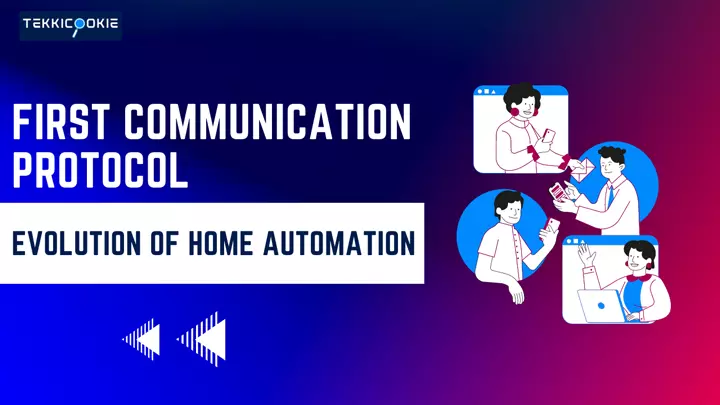In the dynamic world of home automation, where cutting-edge technologies shape our living spaces, it’s essential to understand the origins of the communication protocols that have revolutionized the way we interact with our homes.
In this article, we embark on a journey to uncover the first communication protocol for home automation, shedding light on its significance and impact. Join us as we delve into the annals of history to reveal the foundation upon which our modern smart homes have been built.

The Inception of X10: Pioneering Home Automation
The first communication protocol for home automation can be traced back to the 1970s, a time when technology enthusiasts sought ways to control household devices remotely.
Among the pioneers of this movement was X10, the very first communication protocol for home automation. Developed in 1975, X10 utilized powerline wiring to transmit control signals between devices, marking a significant milestone in the evolution of smart homes.
Unravelling the X10 Protocol
The X10 protocol harnessed the existing electrical wiring infrastructure of homes to facilitate communication between devices. By superimposing control signals on the powerline, X10 allowed homeowners to remotely control lights, appliances, and other electrical devices using specialized modules.
This groundbreaking technology paved the way for a new era of convenience and control within domestic environments.
The X10 protocol employed a simple but effective mechanism for transmitting commands. It utilized a binary command format, where devices interpreted signals as either “on” or “off.” For example, sending an “on” command to a specific X10 module would activate the corresponding device, while an “off” command would deactivate it.
Read More: Most Popular Home Automation Protocol
Functionality and Limitations
While X10 laid the foundation for the first communication protocol for home automation, it’s crucial to understand its functionality and limitations. X10 operated on a powerline carrier frequency of 120 kHz, which allowed the transmission of control signals through electrical wiring.
The simplicity of the binary command format facilitated basic control of devices, making it possible to turn lights on and off or adjust the brightness level remotely.
However, X10 faced several limitations that influenced its reliability and performance. The powerline wiring system used for communication was susceptible to interference from electrical noise, which could disrupt the transmission of signals.
Additionally, the distance limitations of electrical circuits could impact the range of the X10 system, requiring the use of signal repeaters or amplifiers for larger homes.
Another drawback of the X10 protocol was its relatively slow transmission speed. Sending commands to multiple devices simultaneously could result in delays, affecting the responsiveness of the system. Moreover, the limited number of available addresses for devices constrained the scalability of the X10 network.
Legacy and Impact
Despite its limitations, X10 left an indelible mark on the home automation landscape. It paved the way for subsequent communication protocols and ignited a spark of innovation that continues to shape the industry today.
The concept of controlling devices remotely and automating routine tasks became a reality, setting the stage for the rapid evolution of smart home technologies.
X10’s legacy lies not only in its pioneering role but also in its influence on subsequent communication protocols. Many of the fundamental principles and concepts established by X10, such as device addressing and command transmission, form the building blocks of contemporary protocols, further emphasizing its impact on the field.
The lessons learned from X10’s limitations prompted the development of more sophisticated communication protocols that addressed the challenges faced by their predecessor. Protocols like Zigbee, Z-Wave, and Wi-Fi-based systems have since taken centre stage, offering enhanced reliability, faster transmission speeds, and improved interoperability.
The Evolution Continues
As technology progressed and the demand for more robust and efficient home automation solutions grew, subsequent communication protocols emerged to address the limitations of X10. These modern protocols have not only overcome the limitations of their predecessor but have also expanded the possibilities of home automation.
From advanced lighting control and energy management to comprehensive security systems and immersive entertainment setups, the evolution of communication protocols has transformed the way we experience and interact with our homes.
Zigbee, for instance, utilizes a mesh network topology and operates on the 2.4 GHz frequency band. It offers enhanced reliability and extensive compatibility, allowing for the seamless integration of various smart devices within a Zigbee ecosystem.
Z-Wave, on the other hand, operates on a lower frequency band, enabling better range and penetration through walls and obstacles. With thousands of certified devices, Z-Wave provides a wide range of options for building a comprehensive smart home network.
Wi-Fi-based systems, leveraging the ubiquitous Wi-Fi technology, offer high-speed communication and compatibility with a wide range of devices. They leverage the existing home Wi-Fi network to connect and control smart devices, providing a familiar and accessible solution for homeowners.
Conclusion
Reflecting on the past, we acknowledge the significant role played by X10 as the first communication protocol for home automation. Its ingenuity paved the way for the remarkable advancements we witness today.
While the limitations of X10 led to the development of more sophisticated protocols, we must recognize its historical significance and the foundation it laid for the intelligent homes we now enjoy.
As technology continues to push boundaries, we eagerly anticipate the future of home automation, where connectivity and convenience intertwine to create extraordinary living experiences.
Hey there, folks! If you have liked the article then don’t forget to give us a follow on our social media channels below. That way, you’ll be the first to know about all the exciting updates!